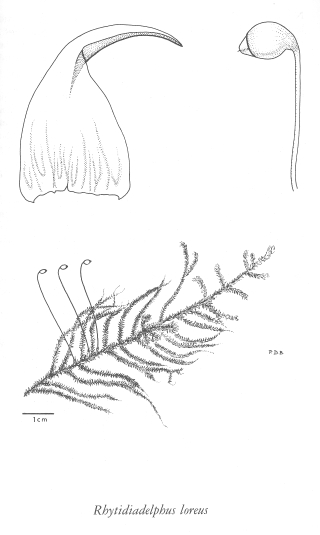Rhytidiadelphus loreus (Hedw.) Warnst.
lanky moss (loreus goose neck moss)
Hylocomiaceae
Species Account Author: Wilf Schofield
Extracted from Some Common Mosses of BC
Introduction to the Bryophytes of BC
lanky moss (loreus goose neck moss)
Hylocomiaceae
Species Account Author: Wilf Schofield
Extracted from Some Common Mosses of BC
Introduction to the Bryophytes of BC
Species Information
Species description:
Genus name meaning "brother of Rhytidium" referring to its resemblance to Rhytidium. Species name meaning striped, possibly referring to the striped appearance made by the pleats on the leaves.
Comments:
R. loreus is commonly used to decorate shop windows and decoratively in hanging baskets of plants. Small decorative animals, including bears, constructed mainly of this moss, are sometimes sold in shops.
Distinguishing characteristics:
The red-brown stems, the falcate leaves at the stem tips, the glossy leaves pleated at the base and lacking obvious midribs, plus the rather coarse, relatively regularly branched plants, are useful features. The species is predominantly on forest floors.
Habit:
Forming loose mats of interwoven, brownish-green to green tinged with red (from the red stems), loosely affixed to the substratum; leaves at the tips of shoots frequently curled mainly in one direction (= falcate-secund).
Similar Species:
R. squarrosus is occasionally difficult to separate from R. loreus. R. squarrosus, however, regularly has squarrose leaves on the main stem and pleats are lacking or obscure in the leaves. R. squarrosus never possesses falcate-secund leaves at the main stem apex and is usually in open sites.
Illustration

If more than one illustration is available for a species (e.g., separate illustrations were provided for two subspecies) then links to the separate images will be provided below. Note that individual subspecies or varietal illustrations are not always available.
Illustration Source: Some Common Mosses of BC
Habitat and Range
Habitat
On rotten logs, forest floors, rocks and occasionally epiphytic up tree bases, usually in humid coniferous forests from sea-level to sub alpine elevations. Range
World DistributionWidespread, mainly in mountain forests, in Europe and on the east and west coasts of North America; in North America extending from Newfoundland southward to Maine in the east; in the west from southeastern Alaska southward to California and inland to western Montana.